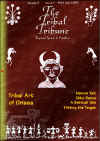Hitting the Target
Makara Sankrati is the most popular festival of Mayurbhanj district of Orissa, which takes place on 14th January every year. Everybody comes closer to celebrate the festival but the Santals celebrate it in more special way and they called it as "Sakrat Parab".There are many rituals involved with this festival but the most important ritual among them is the "Bejha Tuing" (Bejha = Target; Tuing = to Shoot). In this ritual, the village people (male) have to shoot a banana trunk, which is called "bejha". The Ritual:
Origin: The origin of "Bejha Tuing" is based on an interesting story collected by the researcher from Mayabati Hansdah (age-48) from Budamara village, Mayurbhanj. Story: There was an intelligent Majhi named ‘Makara’ in a village. His spouse ‘Sakara’ was a charming lady. But she was a venomous female Cobra assuming a human body. Her paramour, a male cobra was residing a near by jungle. They were secretly meeting each other a particular night like Purnima (full moon) and Amabasya (new moon). One day in the leadership of Makara Majhi all the male persons of the village had gone to the same forest for hunting. In the way they found that male cobra had killed it by arrow, because a snake is believed to be evil during a hunting expedition. The hunting troops returned home in despise. On the occasion of full moonlight Sakara went to meet her beloved (male Cobra) but found it dead. With acute grief and anger she took a vow to avenge on the death of her beloved. She could know that her husband Makara Majhi was the killer. So she waited for a chance to take revenge on him. At every night, Makara and Sakara used to test each other’s intelligence through some funny questions (kudum). Sakara took this opportunity for revenge. She collected a bone piece of her beloved dead cobra and wore it as locket with a necklace. Sakara could know through magical method that the Cobra’s sole was living in a Keya (a type of wild fragrant flower) bush. One night Sakara told Makara that she would like to ask three questions, if Makara can answer, she will be ready to do everything as per orders, but if he fails, Makara has to do whatever asked to do by Sakara. Makara agreed with her and took it lightly because he loved his wife blindly. Sakara’s first question – "What she was wearing as locket around her neck?" Second question, "What is staying inside the ‘Keya’ bush?" The storyteller could not remember the third question. Although Makara was a wise man, he was not able to give any answer to her questions. Then according to their pact Sakara told, "Now, you have to keep your promise. You have to do whatever I say. And it is my order that the villagers will kill you by arrow at the end of the village". This order pained Makara deeply, but he had promised to her wife. As a true lover he prepared to die. A particular day was fixed to shoot him, which was the "Sankrati"(i.e. the time between last and first day of a month). To see the kith and kin for the last time Makara invited all. On the same day his sister was coming from her in-law’s house with a small baby. The blistering heat made her faint and she was compelled to take rest beneath a mango tree. At the same time, two crows were talking with each other about what was going to happen with Makara. A crow was asking to another that why the Makara was going to be shoot. Then the another crow made it clear that "Sakara was the root of all evil. To take revenge on her lover’s murder (Makara) she had woven the net of conspiration. She had asked three questions to Makara, which were impossible to be answered. If some could say the secrecy to Makara, he can escape from death". Knowing about this conspiration, Makara’s sister ran to home and explained everything to her brother. Makara gave answer to Sakara and as per their pact she prepared herself to die. Sakara stood at a place and Makara took his bow and shot an arrow to Sakara at first. Then other villagers launched their arrows on her body. Sakara breathed her last. Her sole was released of human and united with the soul of her beloved living in the Keya bush. To commemorate this mythical incidence, every year in the same time, the Santals put up a banana trunk as a target (representing Sakara) at the end of the village and shoot arrows, after their headman Majhi releases the first arrow. "Makara Sankrati" is a festival observed by rural agricultural people, all over India under various names. After reaping harvest, people enjoy by merry making and associating the supernatural powers with it. The Santals peasants are no exception. They became agriculturist but did not leave their past hunting habits. Archery practices are becoming obsolete now, but a good target hitter is always a hero. This ‘bejha tuning’ festival is a marker of that dying culture. |
Photographs : By the Author
Note:
References :
Translated by : Yudhisthir Behera







